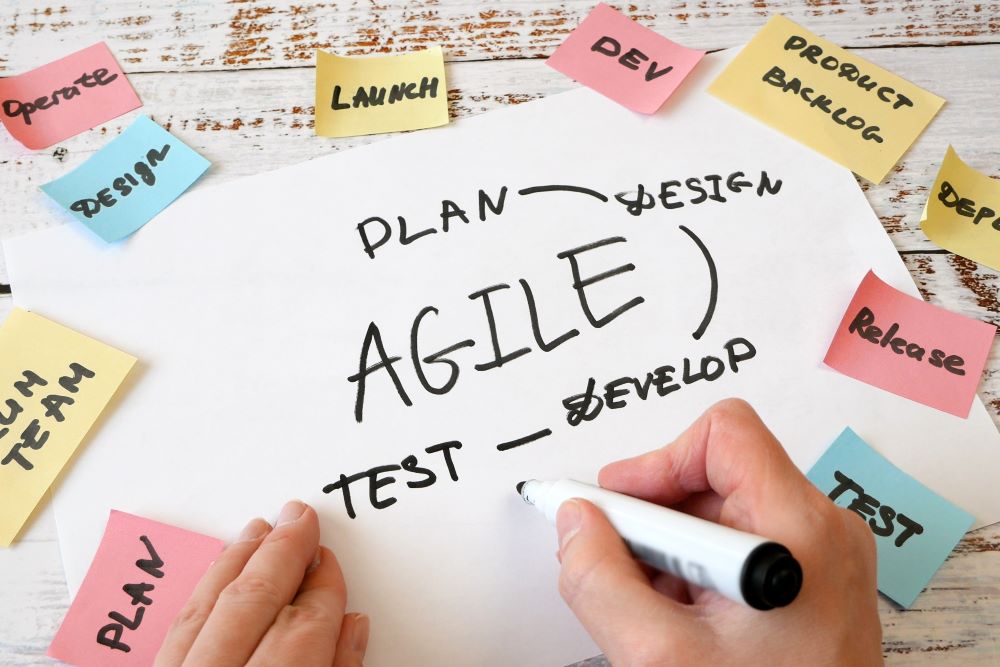The meaning of increment and incremental delivery
Rapid IT development and the rapidly changing needs of the business world are a constant challenge for software development. Traditional methods are often slow, costly and difficult to adapt to new requirements. The concepts of incremental and incremental delivery offer innovative solutions to these problems in agile development. In this article we will now look at what incremental delivery is and what incremental means. We will show how the incremental model can change traditional development paradigms and the benefits it can bring.

The meaning of incrementum
The increment in agile development projects refers to the smaller, independent parts of the product produced in iterations that form a larger whole.
The Scrum Guide mentions these as a concrete step on the way to the product goal. Each increment adds to all previous increments, which are checked thoroughly, ensuring that all increments work together. To add value, the increment must be usable.

What is the incremental model and how does incremental transport work?
The incremental model is mainly used to create large and complex systems. It is based on the idea of adding new features, or increments, to an existing system, rather than building it from scratch all at once.
Incremental delivery is the regular release of constantly growing and evolving versions of a product, its functionality, during agile development.
Incremental and incremental transport in practice
The word incremental may sound foreign to those who are new to scrum or agile product development. To make it easier to understand, let's take a software project, of which different versions are debuting. An increment represents the latest stable release of a product.
The product is developed incrementally, with each increment attempting to be more valuable than the last, for example by offering more features. Stable means that each increment meets the Definition of Done and is usable by users.
Thus, in the incremental model, software requirements are broken down into a number of independent modules or increments over the software development lifecycle. The incremental development is carried out in different phases, which include all the analysis, design, implementation, testing, verification and maintenance required. The functionality of each phase is based on the functionality previously built and this process is repeated until the software is ready.
In the incremental model, the development team tries to complete each phase as quickly as possible. The aim is to deliver a working product, bit by bit. The process involves regular releases, and each release results in an increase in functionality and quality.

Types of incremental transport models
There are two types of incremental models in the software development lifecycle:
Staggered transport model
In this type of incremental model, only one phase of the project is built at a time. This allows the product or service to be developed and delivered in stages, with each stage building on the previous one.
Parallel transport model
In this type of incremental model, different subsystems are built simultaneously. This can reduce the time needed for the development process, provided sufficient resources are available.
Characteristics of incremental transport
Let's now look at the key features of the incremental model:
- The project is divided into smaller increments, which are developed and tested one by one. As a result, the software consists of several small sub-projects.
- The final product is only fully finished after the last increment is completed.
- All requirements and stages are ranked and the highest priority is dealt with first.
- Each increment goes through the stages of analysis, design, programming and testing.
The stages of the incremental model
The incremental model is an iterative process that helps to identify and correct errors early in the development process.
It consists of four main sections:
Requirements and analysis
This phase involves gathering and analysing the project requirements, including the scope, objectives and constraints of the project. It also includes defining the overall project plan and identifying the resources needed to complete the project.
Once this document is ready, it goes through a series of reviews and revisions before moving on to the next phase.
Design
At this stage, the project team develops a detailed plan for the implementation of the project, including the design of the system, the selection of appropriate technologies and the development of the necessary prototypes or proof of concept.
Programming and implementation
This is the actual implementation of the project by writing the code according to the product requirements. This stage allows the physical execution of the designs.
Testing
In the testing phase, the various components of the system and the additional functions are checked, integrated and tested as a whole. After each code implementation, the product is tested to ensure that it works properly with other code fragments already written for the project. The system is then deployed in the environment where it will be used by the end users.
Incremental model vs. waterfall model
The waterfall model is one of the first and most widely used project management methodologies. It used to be widely used in software development, but because it is less applicable in a volatile environment, agile methodologies are now used instead.
Now let's look at the main differences between the traditional waterfall model and the incremental model.
Incremental model
In the incremental model, product development is broken down into smaller pieces (increments). These are designed, developed and tested one by one, each adding new features to the product as it evolves.
Waterfall model
The waterfall model is a linear, sequential process where each phase of development must be completed before the next phase can begin.
It is called a waterfall model because the development process flows downwards in a linear fashion, like a waterfall. The model includes communication, design, model building, manufacturing and deployment in a sequential manner.
Comparison of the incremental model and the waterfall model
Incremental model | Waterfall model |
Low cost | Low cost |
Uses an iterative framework | Uses a linear framework |
Easy to change | Not easy to change |
Works for small and large teams | Works for large teams |
Planning at an early stage is needed | Planning at an early stage is needed |
Low level of risk | High level of risk |
There is some chance of reuse | Little chance of reusability |
Testing takes place after each phase iteration | Testing will take place at the end of the development phase |
It is possible to return to a previous step or phase | It is not possible to return to a previous step or phase |
Working software requires short waiting times | Working software requires long waiting times |
The benefits of incremental transport
Now let's see what are the main advantages of the incremental model:
Lower project risk
When projects are broken down into smaller parts, teams understand and manage risks more easily. Because each aspect of the project is tested in stages, they are more likely to identify risks earlier in the process so they can take steps to mitigate them.
Better project quality
If teams can test their project in stages, they can find and fix problems before they have a serious impact. They are therefore more likely to produce a high-quality product.
Increased productivity
It allows you to plan and organise your work more effectively. This approach can also help reduce the risk of bottlenecks or dependency problems.
Greater transparency
The incremental model helps to improve project visibility by providing regular milestones for teams to work on. These milestones allow progress to be tested, problems to be identified and plans to be adjusted accordingly.
More effective team collaboration
If teams are able to break down their projects into smaller parts, they can better manage their resources and dependencies, which can help improve collaboration between teams.
Feedback option
In the incremental model, the user or customer can provide feedback at all levels, avoiding abrupt changes.
Do you want to deepen your knowledge of agile methodologies? Develop your practical tools and get international certifications! Check out our current Agile training courses!

 Designabc
Designabc